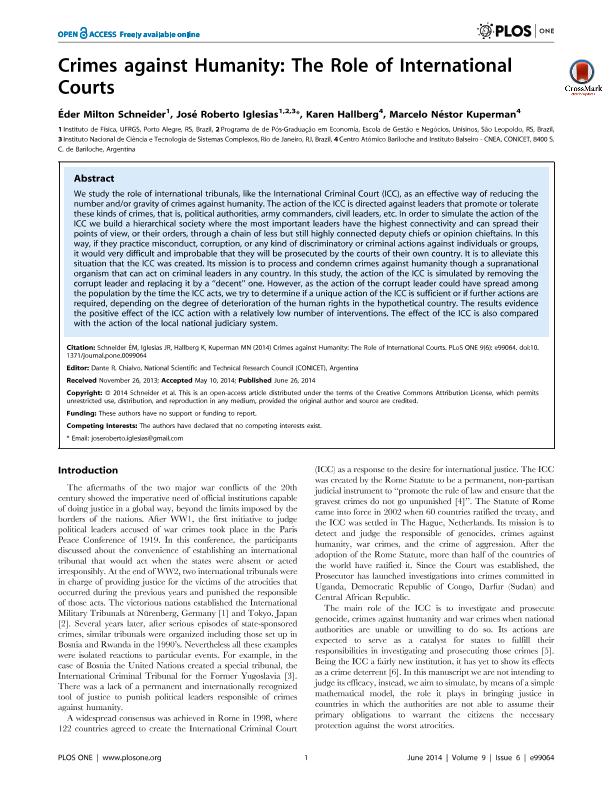Mostrar el registro sencillo del ítem
dc.contributor.author
Schneider, Éder Milton
dc.contributor.author
Iglesias, José Roberto

dc.contributor.author
Hallberg, Karen Astrid

dc.contributor.author
Kuperman, Marcelo Nestor

dc.date.available
2022-12-07T13:01:26Z
dc.date.issued
2014-06
dc.identifier.citation
Schneider, Éder Milton; Iglesias, José Roberto; Hallberg, Karen Astrid; Kuperman, Marcelo Nestor; Crimes against humanity: the role of international courts; Public Library of Science; Plos One; 9; 6; 6-2014; 1-7
dc.identifier.issn
1932-6203
dc.identifier.uri
http://hdl.handle.net/11336/180494
dc.description.abstract
We study the role of international tribunals, like the International Criminal Court (ICC), as an effective way of reducing the number and/or gravity of crimes against humanity. The action of the ICC is directed against leaders that promote or tolerate these kinds of crimes, that is, political authorities, army commanders, civil leaders, etc. In order to simulate the action of the ICC we build a hierarchical society where the most important leaders have the highest connectivity and can spread their points of view, or their orders, through a chain of less but still highly connected deputy chiefs or opinion chieftains. In this way, if they practice misconduct, corruption, or any kind of discriminatory or criminal actions against individuals or groups, it would very difficult and improbable that they will be prosecuted by the courts of their own country. It is to alleviate this situation that the ICC was created. Its mission is to process and condemn crimes against humanity though a supranational organism that can act on criminal leaders in any country. In this study, the action of the ICC is simulated by removing the corrupt leader and replacing it by a "decent" one. However, as the action of the corrupt leader could have spread among the population by the time the ICC acts, we try to determine if a unique action of the ICC is sufficient or if further actions are required, depending on the degree of deterioration of the human rights in the hypothetical country. The results evidence the positive effect of the ICC action with a relatively low number of interventions. The effect of the ICC is also compared with the action of the local national judiciary system.
dc.format
application/pdf
dc.language.iso
eng
dc.publisher
Public Library of Science

dc.rights
info:eu-repo/semantics/openAccess
dc.rights.uri
https://creativecommons.org/licenses/by/2.5/ar/
dc.subject
STATISTICAL MECHANICS
dc.subject
COMPLEX NETWORKS
dc.subject
SOCIAL DYNAMICS
dc.subject.classification
Otras Ciencias Físicas

dc.subject.classification
Ciencias Físicas

dc.subject.classification
CIENCIAS NATURALES Y EXACTAS

dc.title
Crimes against humanity: the role of international courts
dc.type
info:eu-repo/semantics/article
dc.type
info:ar-repo/semantics/artículo
dc.type
info:eu-repo/semantics/publishedVersion
dc.date.updated
2022-12-06T17:13:16Z
dc.journal.volume
9
dc.journal.number
6
dc.journal.pagination
1-7
dc.journal.pais
Estados Unidos

dc.journal.ciudad
San Francisco
dc.description.fil
Fil: Schneider, Éder Milton. Universidade Federal do Rio Grande do Sul; Brasil
dc.description.fil
Fil: Iglesias, José Roberto. Universidade Federal do Rio Grande do Sul; Brasil. Universidad de Vale do Rio dos Sinos; Brasil. Instituto Nacional de Ciencia e Tecnologia de Sistemas Complexos; Brasil
dc.description.fil
Fil: Hallberg, Karen Astrid. Consejo Nacional de Investigaciones Científicas y Técnicas. Centro Científico Tecnológico Conicet - Patagonia Norte; Argentina. Comisión Nacional de Energía Atómica. Gerencia del Área de Investigación y Aplicaciones No Nucleares. Gerencia de Física (Centro Atómico Bariloche); Argentina
dc.description.fil
Fil: Kuperman, Marcelo Nestor. Consejo Nacional de Investigaciones Científicas y Técnicas. Centro Científico Tecnológico Conicet - Patagonia Norte; Argentina. Comisión Nacional de Energía Atómica. Gerencia del Área de Investigación y Aplicaciones No Nucleares. Gerencia de Física (Centro Atómico Bariloche); Argentina
dc.journal.title
Plos One

dc.relation.alternativeid
info:eu-repo/semantics/altIdentifier/url/https://journals.plos.org/plosone/article?id=10.1371/journal.pone.0099064
dc.relation.alternativeid
info:eu-repo/semantics/altIdentifier/doi/http://dx.doi.org/10.1371/journal.pone.0099064
Archivos asociados
